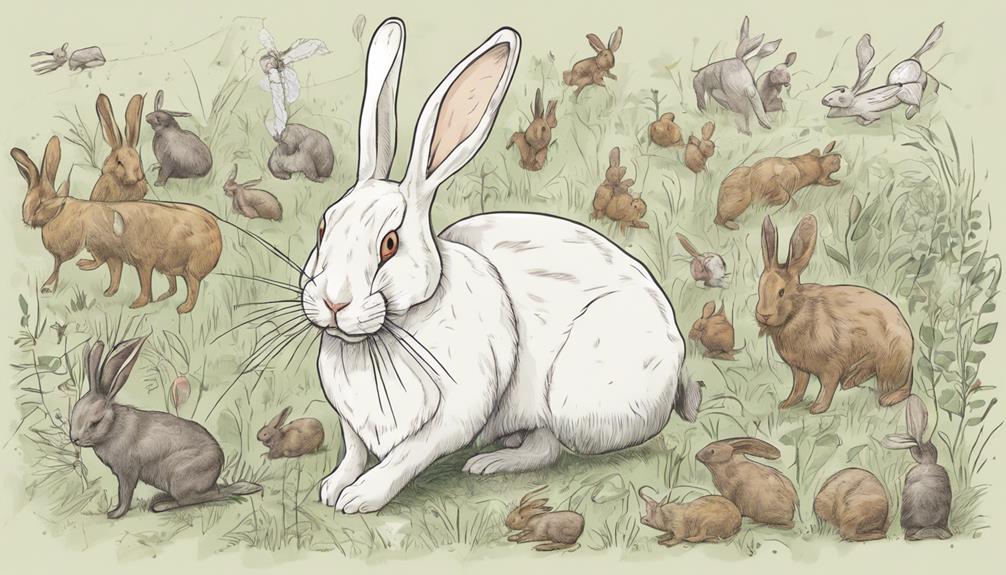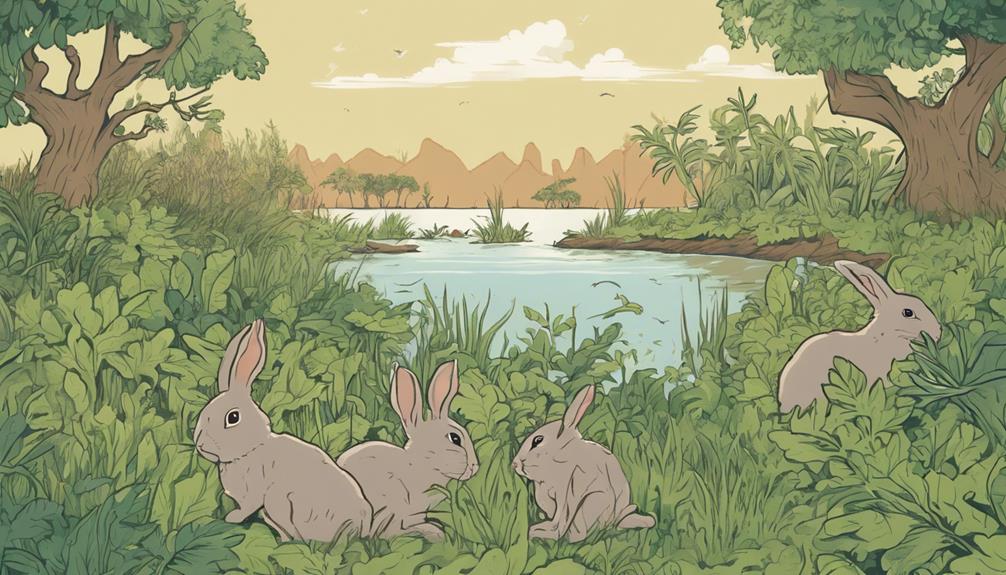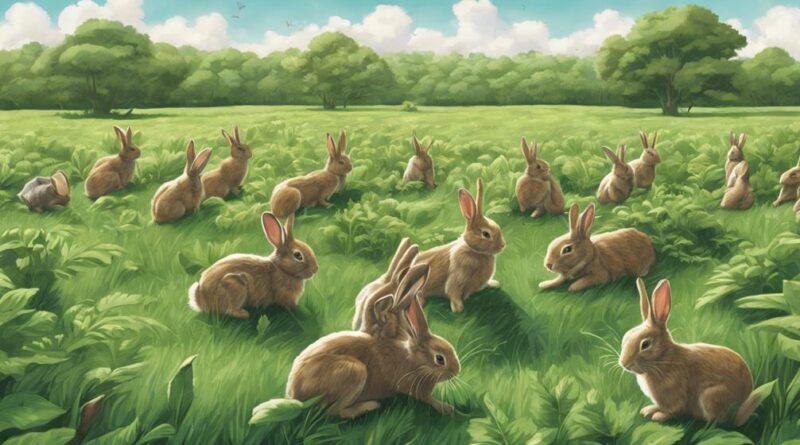10 Best Examples: Rabbits' Impact as Invasive Species
Discover how European Rabbits in Australia and other invasive populations disrupt ecosystems, cause economic losses, and threaten biodiversity. Their rapid reproduction and lack of predators lead to imbalances, soil erosion, and agricultural damage. By altering plant communities and spreading diseases, rabbits impact native vegetation and human health. As they compete for resources and reshape ecosystems, the delicate balance within habitats is strained. Learn more about the significant ecological and economic repercussions of rabbit invasions.
European Rabbits in Australia
European Rabbits have had a significant impact as an invasive species in Australia, causing widespread ecological damage and economic losses. The population dynamics of European Rabbits in Australia are a cause for concern. Introduced in the 18th century, their population has exploded due to the absence of natural predators and their high reproductive rate. The rapid increase in rabbit numbers has disrupted the ecological balance in various habitats across the country.
The unchecked proliferation of European Rabbits has led to a multitude of issues. They compete with native species for resources, leading to a decline in biodiversity. By outcompeting native herbivores for food, they affect the vegetation structure and composition. Additionally, their burrowing activities cause soil erosion and damage to agricultural lands, impacting farmers' livelihoods.
The European Rabbits' impact on the ecological balance is profound. Their voracious feeding habits have altered vegetation patterns, leading to the degradation of ecosystems. This disruption cascades through the food chain, affecting other wildlife dependent on the same resources. The overgrazing by rabbits has resulted in a loss of plant species diversity and a shift in ecosystem dynamics.
Impact on Native Vegetation
The impact of rabbits on native vegetation in Australia is a critical aspect of their invasive presence, reshaping ecosystems and altering plant communities. Rabbits, through their extensive grazing habits, have been known to cause significant ecosystem disruption. They consume various plant species, leading to changes in vegetation composition and structure. This alteration can have cascading effects on other organisms dependent on these plants for food and habitat.
In addition to their grazing habits, rabbits also pose a threat through competition with native herbivores. By outcompeting species like wallabies and kangaroos for food resources, rabbits can further strain the delicate balance within the ecosystem. The increased pressure on native vegetation from rabbit consumption and competition can result in reduced biodiversity and even local extinctions of plant species.
Moreover, rabbits play a role in seed dispersal, albeit not in a beneficial manner. Their foraging activities can lead to the spread of seeds from invasive plant species, further exacerbating the challenges faced by native vegetation. This unintentional seed dispersal by rabbits contributes to the degradation of natural habitats and can hinder efforts towards conservation and restoration.
Agricultural Damage by Rabbits
Rabbits' impact extends beyond native vegetation to agricultural sectors, where their presence poses significant challenges and economic losses. One of the primary issues caused by rabbits in agriculture is crop devastation. Rabbits are voracious herbivores that can quickly decimate crops, leading to substantial financial losses for farmers. This damage not only affects the current harvest but can also have long-term impacts on the productivity of the land.
Farmers face significant challenges in controlling rabbit populations to mitigate this agricultural damage. Implementing effective pest control measures is crucial but can be costly and labor-intensive. Traditional methods such as fencing and trapping are often employed, but these may not always provide a sustainable solution, especially in larger agricultural areas.
Furthermore, the ecological balance within farming ecosystems is disrupted by the presence of an overabundance of rabbits. As herbivores, rabbits can alter plant compositions and reduce biodiversity, impacting the overall health of the ecosystem. This disruption can have cascading effects on other species within the agricultural environment, further complicating the delicate balance required for successful farming practices.
Rabbits and Soil Erosion
Soil erosion rates can be influenced by the presence of invasive rabbit populations in agricultural landscapes. The burrowing behavior of rabbits can exacerbate soil erosion by loosening soil structure and creating pathways for water to flow, leading to increased sediment runoff. This behavior can be particularly damaging in areas where vegetation cover is already compromised due to overgrazing by rabbits.
Moreover, rabbits' grazing habits can further contribute to soil erosion. By consuming large amounts of vegetation, rabbits can reduce the root systems that help hold soil in place, making it more susceptible to erosion by wind and water. This loss of vegetation also hinders ecosystem restoration efforts, as it can impede the natural regeneration of plant species that play a crucial role in stabilizing soil and preventing erosion.
To mitigate the impact of rabbits on soil erosion, effective control measures need to be implemented. This may involve strategies such as habitat modification to deter rabbits from burrowing, fencing to limit their access to vulnerable areas, and targeted removal of rabbit populations in heavily affected regions. By addressing the root causes of soil erosion associated with invasive rabbit populations, it's possible to not only protect agricultural landscapes but also promote healthier ecosystems that support biodiversity and sustainable land management practices.
Rabbits' Effect on Biodiversity
With their rapid reproductive rates and voracious appetites, rabbits significantly impact biodiversity in ecosystems they invade. These herbivores exert predatory pressure on various plant species, leading to cascading effects on the entire ecosystem. By consuming large quantities of vegetation, rabbits can significantly alter the composition and structure of plant communities, affecting the availability of resources for other species. This change in vegetation dynamics can disrupt the delicate balance of the ecosystem, potentially leading to a decrease in overall biodiversity.
Moreover, rabbits also influence competition dynamics among different species within the ecosystem. Their feeding habits can give certain plant species a competitive advantage over others, leading to shifts in species dominance. This alteration in species composition can have far-reaching effects on other organisms that rely on specific plant species for food and habitat. In essence, the presence of rabbits can reshape the biodiversity of an ecosystem by impacting the interactions between various plants and animals.
Control Measures for Rabbit Population
The management of rabbit populations through strategic interventions plays a pivotal role in mitigating their detrimental impact on biodiversity within ecosystems. Two primary methods used for controlling rabbit populations are trap and release programs and fertility control measures.
Trap and release programs involve capturing rabbits using humane traps and relocating them to areas where their impact on biodiversity is minimized. This method helps reduce rabbit numbers in areas where they're causing significant harm while also preventing harm to the rabbits themselves.
Fertility control is another effective strategy for managing rabbit populations. By implementing fertility control measures such as immunocontraception or hormonal treatments, the reproductive rates of rabbits can be reduced. This approach offers a humane and sustainable way to control rabbit populations without resorting to culling.
Both trap and release programs and fertility control methods have been successful in various regions in managing rabbit populations. However, the effectiveness of these measures can vary depending on the specific circumstances of the ecosystem and the density of the rabbit population. Continued research and monitoring are essential to evaluate the success of these control measures and to adapt strategies as needed to ensure the long-term conservation of biodiversity within ecosystems.
Rabbits as Disease Vectors

Rabbits serve as significant disease vectors within ecosystems, posing potential risks to both wildlife and human populations. Disease transmission can occur through various means, impacting the ecological balance in significant ways. Here are some key points to consider:
- Rabbit Hemorrhagic Disease (RHD): This highly contagious virus affects both domestic and wild rabbits, causing internal bleeding and high mortality rates.
- Tularemia: Rabbits can carry the bacterium Francisella tularensis, which can be transmitted to humans through contact with infected animals or contaminated environments.
- Myxomatosis: This viral disease, often spread by rabbit fleas or mosquitoes, can lead to severe swelling and death in infected rabbits.
- Leptospirosis: Rabbits can harbor Leptospira bacteria, which can infect humans through contact with contaminated water or soil.
- Ecological Imbalance: The introduction of diseases by rabbits can disrupt the natural balance of ecosystems, leading to cascading effects on other wildlife species.
Understanding the role of rabbits as disease vectors is crucial for managing their populations effectively and mitigating the risks associated with disease transmission. By addressing these issues, we can work towards maintaining a healthier ecological balance and reducing the potential threats posed by invasive rabbit populations.
Economic Impact of Rabbit Invasions
Invasive rabbit populations have been shown to have significant economic impacts on various sectors due to their destructive behaviors and rapid reproduction rates. One of the key areas affected is tourism revenue. Rabbits can damage landscapes, impacting the aesthetic appeal of natural sites and reducing their attractiveness to tourists. This decline in tourism can lead to a direct loss in revenue for businesses reliant on visitors to these areas.
Resource competition is another economic aspect influenced by rabbit invasions. Rabbits consume large amounts of vegetation, competing with native wildlife and livestock for food sources. This competition can result in reduced crop yields for farmers, leading to financial losses in agricultural sectors. Additionally, the degradation of habitats caused by rabbits can impact the availability of resources for other species, disrupting ecosystems and potentially affecting industries reliant on ecosystem services.
Rabbits in Island Ecosystems

Exploring the ecological ramifications of rabbit presence in island ecosystems reveals intricate interactions between the introduced species and local biodiversity. The introduction of rabbits to island ecosystems can have significant impacts on the native flora and fauna, leading to conservation challenges and disruptions in ecological balance. Here are some key points to consider:
- Island ecosystems: Islands often have unique and fragile ecosystems due to their isolation, making them particularly vulnerable to invasive species like rabbits. The limited resources and specialized species on islands can suffer greatly from the presence of rabbits.
- Conservation challenges: Managing rabbit populations in island ecosystems presents unique challenges for conservation efforts. The eradication of rabbits can be difficult due to the limited size of the islands and the potential for rapid population regrowth.
- Rabbit population: Unchecked rabbit populations can quickly decimate native vegetation on islands, leading to habitat loss and decreased biodiversity. Controlling rabbit numbers is crucial for preserving the delicate balance of island ecosystems.
- Ecological balance: Rabbits can outcompete native species for resources, disrupt food chains, and alter vegetation patterns. These changes can have cascading effects on the entire ecosystem, affecting everything from soil composition to bird populations.
- Impact on native species: The presence of rabbits in island ecosystems can directly impact native species through predation, competition for resources, and habitat destruction. Protecting native flora and fauna from these threats is essential for maintaining the ecological integrity of island ecosystems.
Future Challenges in Rabbit Management
The ongoing management of rabbit populations in island ecosystems poses complex challenges that require strategic and adaptive approaches to prevent further ecological disruptions. As rabbits reproduce rapidly and are adept at exploiting available resources, controlling their populations presents a formidable task. One of the primary challenges ahead lies in developing sustainable management strategies that effectively curb rabbit numbers while minimizing impacts on native flora and fauna.
Invasive rabbit populations can significantly alter island ecosystems by overgrazing vegetation, leading to soil erosion and habitat degradation. To address these issues, integrated pest management techniques combining biological controls, such as the use of rabbit-specific viruses, with physical methods like fencing have shown promise in reducing rabbit densities. However, the evolution of resistance to control measures poses a persistent challenge that necessitates ongoing research and innovation.
Furthermore, the interconnected nature of island ecosystems complicates rabbit management efforts. Introducing control measures can inadvertently affect other species or disrupt delicate ecological balances. Therefore, future strategies must consider the broader ecosystem dynamics to mitigate unintended consequences.
Frequently Asked Questions
Can Rabbits Interbreed With Native Species?
Yes, rabbits can interbreed with native species, leading to genetic implications and hybridization risks. This can result in ecological competition, threatening native biodiversity.
It's crucial to monitor and manage these interactions to prevent negative consequences on the local ecosystem.
Are There Any Benefits of Rabbits in Ecosystems?
In ecosystems, rabbits can disrupt ecological balance by outcompeting native species for resources and causing habitat degradation. However, they can also contribute to biodiversity preservation by serving as prey for predators and helping regulate plant populations.
Despite their negative impacts, understanding the role of rabbits in ecosystems is crucial for maintaining a healthy balance of species and preserving overall biodiversity.
How Do Rabbits Affect Water Sources?
Rabbits can have a significant impact on water sources due to their feeding habits and burrowing activities. Their grazing can lead to soil erosion and habitat destruction, affecting the stability of riverbanks and lake shores.
Additionally, rabbit waste can contaminate water sources, disrupting ecosystems and potentially harming other wildlife. These factors highlight the role of rabbits as contributors to water quality issues in certain environments.
Do Rabbits Have Predators in Invaded Habitats?
In invaded habitats, rabbits face predators that play a crucial role in maintaining ecological balance. Predation dynamics in these settings can impact rabbit populations and lead to coexistence strategies.
However, some invasive rabbit species may outcompete native species for resources, disrupting habitat competition. Understanding these interactions is vital for managing invasive species and preserving biodiversity in affected ecosystems.
Can Rabbits Adapt to Extreme Climates?
In harsh climates, rabbits can exhibit impressive survival strategies. Their genetic diversity allows for adaptation to extreme conditions.
Behavioral adaptations, such as burrowing or changing activity patterns, help them cope with climate change.
Conclusion
In conclusion, rabbits have demonstrated significant negative impacts as invasive species in various ecosystems around the world. From Australia to island ecosystems, their presence has led to destruction of native vegetation, agricultural damage, soil erosion, loss of biodiversity, and economic consequences.
As disease vectors, rabbits pose additional threats to both wildlife and human populations. Moving forward, effective management strategies must be implemented to mitigate the ongoing challenges posed by rabbit invasions.
